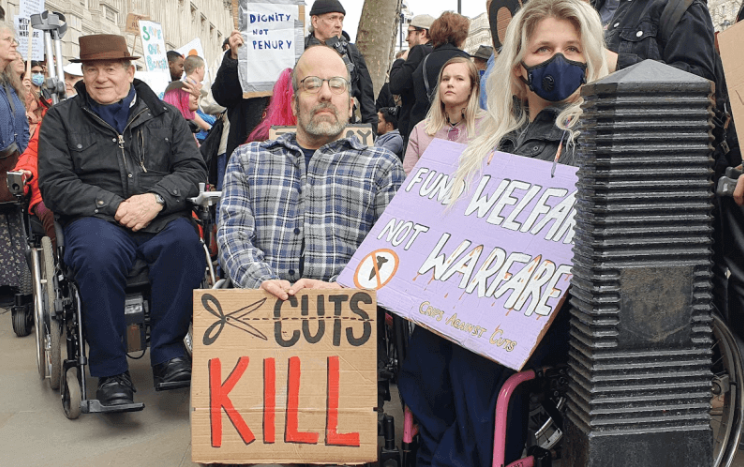Labour’s cuts to PIP will drag a quarter of a million people into absolute poverty, DWP figures show
The government’s decision to tighten eligibility for personal independence payment (PIP) will drag a quarter of a million working-age people into absolute poverty* by 2030, official documents have revealed.
Although the Department for Work and Pensions (DWP) has for some reason failed to calculate the increase in disability poverty caused by the various cuts and reforms announced in last week’s disability benefits green paper, it has carried out calculations showing how many working-age people will be affected.
They show that 250,000 working-age people will be drawn into absolute poverty due to the PIP cuts, and it is certain that almost all of these will be disabled people.
The figure is just one crucial detail in several documents published yesterday (Wednesday) by DWP, the Treasury, and the Office for Budget Responsibility (OBR), alongside the spring statement delivered by the chancellor, Rachel Reeves.
An equality analysis by DWP estimates that 3.1 million households with at least one disabled member will lose out through the overall package of cuts and reforms by 2029-30, with an average loss of £1,730 a year.
Another 1.8 million households with at least one disabled member will gain, but only by an average of £560 a year.
Reeves told MPs yesterday that the government will be cutting £4.8 billion a year from spending on social security by 2029-30 – although it is not clear from the Treasury figures how she has calculated that figure.
This is because spending on PIP being cut by more than £4.5 billion, while there will also be £3 billion in cuts to the health element of universal credit**, and the impact of other measures has yet to be calculated.
The impact of the cuts on disabled people were revealed as more than 1,000 disabled people and allies protested outside Downing Street and parliament yesterday as part of a protest organised by Disabled People Against Cuts, Inclusion London and Stop the War Coalition, and supported by many other grassroots groups and unions.
Other protests took place across England, Northern Ireland, Scotland and Wales under the same #WelfareNotWarfare banner.
The actions came as Disability News Service (DNS) reports today how the body of a disabled man was found in his flat last month in distressing, squalid conditions, just weeks after DWP wrongly removed his PIP because he had failed to return a review form he was too ill to complete (see separate story).
His death highlights yet again the major concerns about DWP’s ability to cut safely billions of pounds from disabled people’s support, without risking the lives of countless claimants.
Of the cuts laid out in last week’s Pathways to Work green paper, the new documents published yesterday show the greatest impact will be caused by DWP’s decision that, from next year, PIP claimants must score a minimum of four points in at least one daily living activity to be eligible for the daily living part of the benefit.
This will see, by 2029-30, 370,000 current PIP recipients losing their daily living entitlement when their award is reviewed, and 430,000 future recipients not receiving the PIP they would otherwise have received, at an average loss of £4,500 a year.
Another measure that will have a significant impact on disabled people is the government’s decision to cut the health element of universal credit for new claimants from £97 per week currently to £50 per week in 2026-27, while freezing it for existing claimants until 2029-30.
This could see 2.25 million current recipients of the health element losing an average of £500 per year in 2029-30, and 730,000 future recipients losing an average of £3,000 per year, although they will all benefit from a small increase in the standard universal credit allowance of £5 per week above inflation by 2029-30.
There remain several important unanswered questions about the government’s reforms.
A key issue is whether OBR is correct in its estimate that 800,000 disabled people will lose the daily living element of PIP through the tightened eligibility, as opposed to the 1.5 million suggested by what it calls the “static costing” of the policy.
OBR seems to suggest the lower number is more likely because of the “strong financial incentive” to qualify for PIP, and the increased number of appeals it expects, but fears will remain that the number losing out could be even higher than 800,000.
Another key question is how many disabled people who receive universal credit and have “the most severe, life-long health conditions”, no prospect of an improvement in their health, and who “will never be able to work”, will no longer be reassessed and will receive an additional premium.
Ministers have yet to decide the size of this premium, and which groups of disabled people will be protected in this way.
OBR also says it is too early to calculate the impact of scrapping the work capability assessment and deciding eligibility for the universal credit (UC) health element through the PIP assessment instead.
Other question-marks remain over the impact of the government’s decision to review the PIP assessment, and to increase the number of face-to-face PIP assessments.
OBR also confirms in its report that the various government cuts amount to the “largest package of welfare savings since the July 2015 Budget”.
And it confirms that – before the cuts – total social security spending was stable as a proportion of GDP, as reported by DNS earlier this month, and that it is now on a “slightly downward trajectory”.
The documents also fail to assess the financial impact of preventing young disabled people claiming the health element of universal credit until they are 22, from 2027 onwards, and of plans to raise the age at which young people transition from disability living allowance to PIP from 16 to 18, a move which will also cut spending.
Meanwhile, the Equality and Human Rights Commission has confirmed to DNS that it is considering whether the measures in last week’s green paper have breached DWP’s public sector equality duty to have “due regard” to how its policies and decisions affect disabled people and other groups protected under the Equality Act.
*The number of people earning below 60 per cent of the average (median) income in 2010-11, adjusted for inflation
**It is also unclear what the final impact of changes to universal credit will be, as the standard allowance will be increased slightly in real terms and some changes to the health element are yet to be finalised
Credit for this article goes to John Pring with the Disability News Service


No responses yet